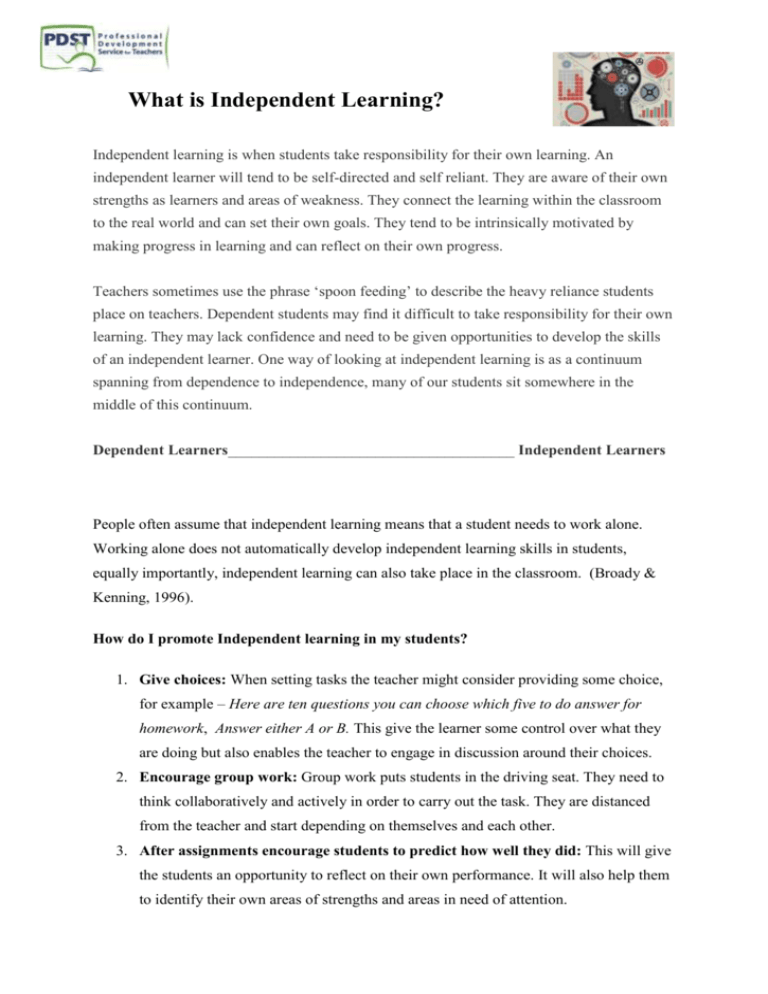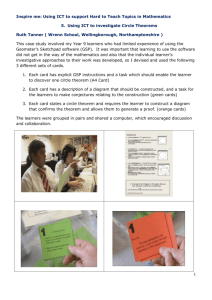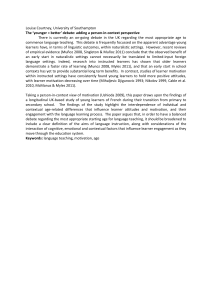Independent learning final
advertisement

What is Independent Learning? Independent learning is when students take responsibility for their own learning. An independent learner will tend to be self-directed and self reliant. They are aware of their own strengths as learners and areas of weakness. They connect the learning within the classroom to the real world and can set their own goals. They tend to be intrinsically motivated by making progress in learning and can reflect on their own progress. Teachers sometimes use the phrase ‘spoon feeding’ to describe the heavy reliance students place on teachers. Dependent students may find it difficult to take responsibility for their own learning. They may lack confidence and need to be given opportunities to develop the skills of an independent learner. One way of looking at independent learning is as a continuum spanning from dependence to independence, many of our students sit somewhere in the middle of this continuum. Dependent Learners_____________________________________ Independent Learners People often assume that independent learning means that a student needs to work alone. Working alone does not automatically develop independent learning skills in students, equally importantly, independent learning can also take place in the classroom. (Broady & Kenning, 1996). How do I promote Independent learning in my students? 1. Give choices: When setting tasks the teacher might consider providing some choice, for example – Here are ten questions you can choose which five to do answer for homework, Answer either A or B. This give the learner some control over what they are doing but also enables the teacher to engage in discussion around their choices. 2. Encourage group work: Group work puts students in the driving seat. They need to think collaboratively and actively in order to carry out the task. They are distanced from the teacher and start depending on themselves and each other. 3. After assignments encourage students to predict how well they did: This will give the students an opportunity to reflect on their own performance. It will also help them to identify their own areas of strengths and areas in need of attention. 4. Setting learning goals: Getting students to set their own learning goals is very empowering but initially it needs scaffolding from the teacher. Again it encourages the students to self reflect and self evaluate. The important thing about setting goals is that you visit it regularly and re assess. Example of learning goal (fig. 1) below: What do I need to How will I do this? How and when will I follow this improve? My vocabulary up? Next month I will ask my teacher Try to use newly acquired words as often whether she has observed any as possible. progress. Regularly check over my vocabulary Talk to her about things that worked notebook. for me. Ask about or look up words that I don’t understand. Adapted from Jo Mynard & Robin Sorflaten (2002) 5. Use authentic texts: Try to incorporate texts like magazines, newpapers, blogs, journals, guides, etc into your lesson. This enables the students to connect the learning with the outside world. Encourage them to bring in their own authentic texts to enhance what is already happening in class. 6. Involve them in the lesson planning: Invite the students to direct the learning from time to time. This gives them a sense of ownership and control over their own learning. 7. Encourage learners to keep reflective learner diaries: This facilitates a conversation between teacher and student about their own learning. It is also a vehicle for the student to honestly express their own comments on their learning. The diaries can be semi-guided initially but gradual ownership will give learners a sense of responsibility (Dam, 2002). 8. Encourage peer and self assessment: Before assignments are handed up to the teacher it is a good idea to ask the students to self edit or peer edit their work. Teachers could help create the editing check list by identifying commonly made mistakes. Create a self-access facility in the classroom A self-access facility can be as simple as a cupboard or shelf containing activities that students can do on their own in order to give them extra practice or extension to what they do in class (Baba, 2001). Materials could include: magazine articles with questions and answers; puzzles; quizzes; graded readers and so on. Adapted from Jo Mynard & Robin Sorflaten, Learning Enhancement Center Coordinators, Zayed University, UAE











